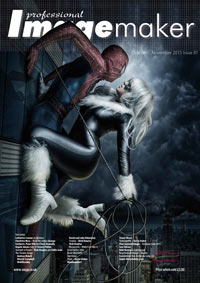articles/Lighting/hypersync3-page2
Dave Montizambert's Creating With Light Part 39 - HyperSync 3 - part 2 of 1 2
by Dave Montizambert Published 01/10/2015
And finally, from my test I observed a one-stop gain in strobe lighting withevery one-stop decrease in shutter-speed: 1/8,000th read f32, 1/4,000thread f22, 1/2,000th read f16 and so on. As I stated earlier, setting the lightusing the recorded incident meter readings from the test automaticallytakes into account any lighting modifiers that I might be using. All I knowis that if I'm shooting at f4 at 1/8,000th at 100 ISO for instance, then I bettermake that light striking the subject read f32 incident. So the recorded meterreadings help me to create a documented correlation that I can recreateany time anywhere with any variation of modifiers. Pretty smart don't youthink? I gave myself a raise after I figured that out! Now that's a lot of info todigest and there is more to it, but that's pretty much the basics. If you wanta more in-depth look at HyperSync, I recently released a new video tutorialabout HyperSync on my 'Dave On Demand' page of my web page (www.montizambert.com).
Tip: When I'm metering, if the light reads too strong, I often feather the lightoff the subject rather than changing distance since the change in distanceaffects light quality more than feathering.
HyperSync Test
HyperSync Settings for White Lighting X3200 at 100 ISO
- 1/8,000 @ f4 = f32 incident at 54" (-6 stops) use -3600 offset
- 1/4,000 @ f4 = f22 incident at 80" (-5 stops) use -3450 offset
- 1/2,000 @ f4 = f16 incident at 111" (-4 stops) use -3300 offset
- 1/1,000 @ f4 = f11 incident at 143" (-3 stops) use -3050 offset
- 1/500 @ f4 = f8 incident at 176" (-2 stops) use -2100 offset
Let me tell you a secret! I'm not a photographer ...I'm a light sculptor - I bend the light to my will, to my vision using lots of cool geeky lighting equipment then immortalise my creation with my camera. I lecture internationally on lighting, digital photography, and Adobe Photoshop.
Please Note:
There is more than one page for this Article.
You are currently on page 2
- Dave Montizambert's Creating With Light Part 39 - HyperSync 3 page 1
- Dave Montizambert's Creating With Light Part 39 - HyperSync 3 page 2
1st Published 01/10/2015
last update 09/12/2022 14:55:07
More Lighting Articles
There are 28 days to get ready for The Society of Photographers Convention and Trade Show at The Novotel London West, Hammersmith ...
which starts on Wednesday 14th January 2026





